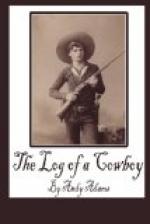We held the wagon and saddle horses in the rear, and when we were half a mile away from the trail ford, cut off about two hundred head of the leaders and started for the crossing, leaving only the horse wrangler and one man with the herd. On reaching the river we gave them an extra push, and the cattle plunged into the muddy water. Before the cattle had advanced fifty feet, instinct earned them of the treacherous footing, and the leaders tried to turn back; but by that time we had the entire bunch in the water and were urging them forward. They had halted but a moment and begun milling, when several heavy steers sank; then we gave way and allowed the rest to come back. We did not realize fully the treachery of this river until we saw that twenty cattle were caught in the merciless grasp of the quicksand. They sank slowly to the level of their bodies, which gave sufficient resistance to support their weight, but they were hopelessly bogged. We allowed the free cattle to return to the herd, and immediately turned our attention to those that were bogged, some of whom were nearly submerged by water. We dispatched some of the boys to the wagon for our heavy corral ropes and a bundle of horse-hobbles; and the remainder of us, stripped to the belt, waded out and surveyed the situation at close quarters. We were all experienced in handling bogged cattle, though this quicksand was the most deceptive that I, at least, had ever witnessed. The bottom of the river as we waded through it was solid under our feet, and as long as we kept moving it felt so, but the moment we stopped we sank as in a quagmire. The “pull” of this quicksand was so strong that four of us were unable to lift a steer’s tail out, once it was imbedded in the sand. And when we had released a tail by burrowing around it to arm’s length and freed it, it would sink of its own weight in a minute’s time until it would have to be burrowed out again. To avoid this we had to coil up the tails and tie them with a soft rope hobble.
Fortunately none of the cattle were over forty feet from the bank, and when our heavy rope arrived we divided into two gangs and began the work of rescue. We first took a heavy rope from the animal’s horns to solid footing on the river bank, and tied to this five or six of our lariats. Meanwhile others rolled a steer over as far as possible and began burrowing with their hands down alongside a fore and hind leg simultaneously until they could pass a small rope around the pastern above the cloof, or better yet through the cloven in the hoof, when the leg could be readily lifted by two men. We could not stop burrowing, however, for a moment, or the space would fill and solidify. Once a leg was freed, we doubled it back short and securely tied it with a hobble, and when the fore and hind leg were thus secured, we turned the animal over on that side and released the other legs in a similar manner. Then we hastened out of the water and into our saddles,




